
Three quick tips to supersize your tomato yields
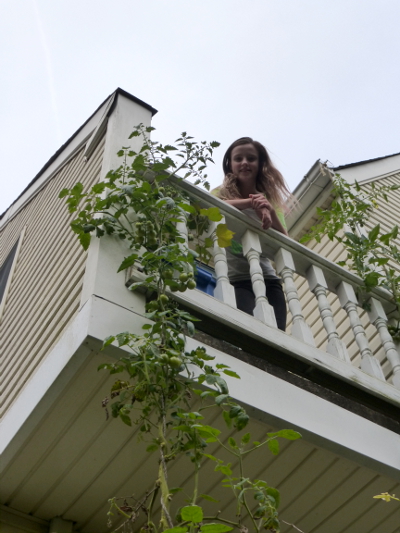 I
can still remember where I was when I first saw it --- a picture of a
man harvesting tomatoes from the top of an extension ladder. Louis Ver
had grown a 23-foot-tall plant a few decades earlier in a town only 45
minutes drive from where I lived in Pennsylvania. Best of all, he had done it
organically and picked over 200 tomatoes from the plant over the course
of the season! I couldn't wait to try it for myself.
I
can still remember where I was when I first saw it --- a picture of a
man harvesting tomatoes from the top of an extension ladder. Louis Ver
had grown a 23-foot-tall plant a few decades earlier in a town only 45
minutes drive from where I lived in Pennsylvania. Best of all, he had done it
organically and picked over 200 tomatoes from the plant over the course
of the season! I couldn't wait to try it for myself.
I loved the colors and flavors of heirloom tomatoes, but was sometimes
disappointed by the yield. I was pretty sure that this was the answer to
my problems. In the years since, I have continued to read and
experiment in an attempt to achieve maximum yields on my tomato plants. I
would like to share a few quick tips that will help you to grow more
tomatoes as well, even if you don't want to leave the safety of the
ground.
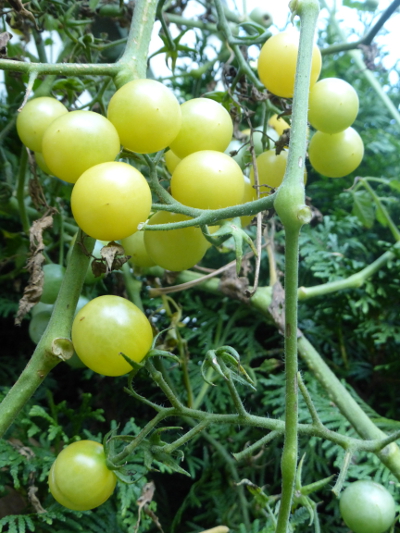 Tip #1: Provide constant moisture.
If a plant has all of the sunlight and fertilizer in the world, and a
wealth of perfect soil beneath it, its growth will still be frustrated
if it doesn't have the moisture it needs. Ruth Stout once had me
convinced that rich soil and a good mulch would retain all of the
moisture that my plants needed. But even when I gave my tomatoes an
occasional gallon of "irrigation tea," per Louis Ver's recommendations, I
ended up realizing that I was dwarfing the plants due to insufficient
moisture.
Tip #1: Provide constant moisture.
If a plant has all of the sunlight and fertilizer in the world, and a
wealth of perfect soil beneath it, its growth will still be frustrated
if it doesn't have the moisture it needs. Ruth Stout once had me
convinced that rich soil and a good mulch would retain all of the
moisture that my plants needed. But even when I gave my tomatoes an
occasional gallon of "irrigation tea," per Louis Ver's recommendations, I
ended up realizing that I was dwarfing the plants due to insufficient
moisture.
Here is the easiest and most efficient way that I have found to water a
very big plant. Drill a hole in the side of a 5 gallon bucket, right
where the bottom and side of the container meet. Set it 1 to 2 feet from
the base of the tomato plant, with the hole aimed toward the plant, and
fill it once weekly, letting the water drain out slowly over 5 to 10
minutes. If you don't have a supply of rain or pond water, let tap water
age in a bucket for a day or more before dumping it in the bucket with a
hole to give any chlorine time to evaporate and the water time to warm
to outdoor temperatures. This slow trickle will create a reservoir of
water in the soil directly beneath your plant that it can draw from over
the course of the week.
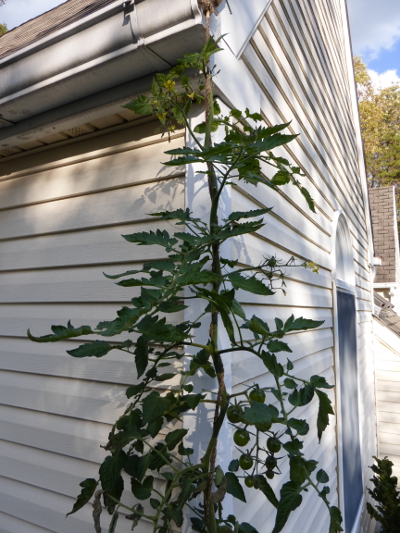 Tip #2: Provide constant fertility.
I've learned that spreading compost around your plant once at the
beginning of growing season is a bit like giving a child a seven-course
meal as soon as they are born and never feeding them again. Of course,
organic fertilizers are known for being slow-release, but this doesn't
mean that they don't lose potency as the elements leach away their
nutrients. It was my pole beans that first convinced me that the "once
and done" plan was foolish. Every year bean production would peter out
at some point, after which I would place a few shovels of compost in a
bucket of water, mix it up, and dump along the row. Within two weeks the
plants were pumping out beans at a machine gun pace again! At some
point I thought, "Why don't I just do this every two weeks all season
long?"
Tip #2: Provide constant fertility.
I've learned that spreading compost around your plant once at the
beginning of growing season is a bit like giving a child a seven-course
meal as soon as they are born and never feeding them again. Of course,
organic fertilizers are known for being slow-release, but this doesn't
mean that they don't lose potency as the elements leach away their
nutrients. It was my pole beans that first convinced me that the "once
and done" plan was foolish. Every year bean production would peter out
at some point, after which I would place a few shovels of compost in a
bucket of water, mix it up, and dump along the row. Within two weeks the
plants were pumping out beans at a machine gun pace again! At some
point I thought, "Why don't I just do this every two weeks all season
long?"
I was on the right track. I soon read about experts who do something
very similar, as Eliot Coleman spreads a "side-dressing" of compost
around each tomato plant monthly and Steve Solomon "fertigates" his
larger plants with a 5-gallon bucket of compost tea every other week. I
often use a method that is a hybrid of the two, slowly dumping a few
gallons of my compost "stew" (compost left in, as with the pole beans)
around the base of the plant twice a month in addition to my watering
schedule. It really doesn't take much compost to maintain fertility in
this manner as long as you planted in good soil or spread 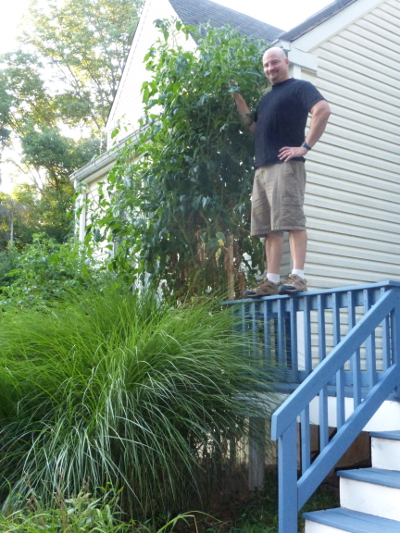 an inch of compost in a two foot wide circle around your transplant; a trowel scoop per gallon of water seems to be adequate.
an inch of compost in a two foot wide circle around your transplant; a trowel scoop per gallon of water seems to be adequate.
Tip #3: Give your plant room to grow.
Years ago, I planted my tomatoes pretty closely, lopped off all suckers
in an attempt to channel the nutrients into that one precious vine, and
trained them up twine to a trellis. I later realized that I was
severely limiting productivity. This method is fine if you have to grow
20 varieties in a twenty foot garden bed, have lots of time for pruning,
and a trellis to train all of your single vines up to, but you won't
get much from each plant. I could have grown more tomatoes with four
plants per bed and my current techniques.
Here are two methods that work best in most situations:
- Giant tomato bush. First, plant your tomato in full sun at least five feet from any other large plant. Next, go to a hardware store and buy two sheets of re-mesh (used to reinforce concrete). Back at home, fasten the ends of one sheet with wire, and you will have a cage 3 1/2' high to set around your tomato plant. Do the same with the second, and then put it on top of the first, wiring it securely in place. Tie the cage to one or two stakes that are pounded in securely to prevent the contraption from tipping when the plant gets big. You now have a 7' tall cage, which will hold your giant tomato "bush" securely for the season, as the vines will have to reach at least 14' in length in order to grow over the top of your cage and back down to the ground. Best of all, most of you will be able to reach all of the tomatoes without even standing on your toes! (The one in the picture is just about to flop and head downward after growing out the top of a 10 1/2' cage.)
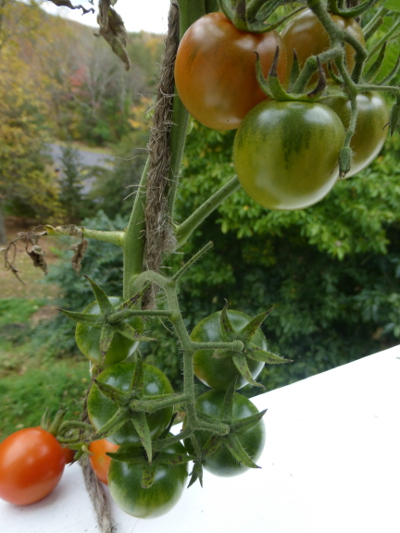 Sky-high climbing vines.
For this method, you'll need to plant your tomato in full sun beneath a
second-story balcony, window, or chimney. Next, buy a rope at least 25'
long made of rough, natural material (I've used sisal.) Third, tie the
rope to something (the balcony railing, chimney, etc.) up on the
second story, and the other end gently to the base of
the tomato plant (wait until it's not too small and tender). Then,
as the plant grows, twist its trunk gently around the rope. You'll need
to get up on the ladder weekly to trim suckers with this method,
but can allow about 4 vines to climb the rope without everything coming
undone, and without limiting your plant's height or productivity. I
harvested 500 cherry tomatoes from a single vine when I first tried
this, and each additional vine can produce just as many!
Sky-high climbing vines.
For this method, you'll need to plant your tomato in full sun beneath a
second-story balcony, window, or chimney. Next, buy a rope at least 25'
long made of rough, natural material (I've used sisal.) Third, tie the
rope to something (the balcony railing, chimney, etc.) up on the
second story, and the other end gently to the base of
the tomato plant (wait until it's not too small and tender). Then,
as the plant grows, twist its trunk gently around the rope. You'll need
to get up on the ladder weekly to trim suckers with this method,
but can allow about 4 vines to climb the rope without everything coming
undone, and without limiting your plant's height or productivity. I
harvested 500 cherry tomatoes from a single vine when I first tried
this, and each additional vine can produce just as many!
Want more in-depth information? Browse through our books.
Or explore more posts by date or by subject.
About us: Anna Hess and Mark Hamilton spent over a decade living self-sufficiently in the mountains of Virginia before moving north to start over from scratch in the foothills of Ohio. They've experimented with permaculture, no-till gardening, trailersteading, home-based microbusinesses and much more, writing about their adventures in both blogs and books.
Want to be notified when new comments are posted on this page? Click on the RSS button after you add a comment to subscribe to the comment feed, or simply check the box beside "email replies to me" while writing your comment.

- Remove comment
